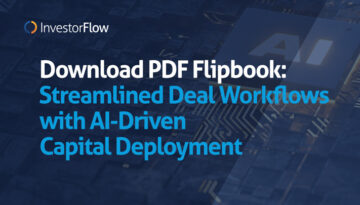Onsite at PEI’s Investor Relations & Fundraising Forum in California
InvestorFlow recently attended the Private Equity International Investor Relations & Fundraising Forum in San Diego, meeting with leading private market firms to discuss strategies and solutions in a changing fundraising environment.
From “fundraising to friendraising,” low effort customization of LP returns, and augmenting capital formation efforts with demonstrated LP interest and intent, here’s what we heard during keynote sessions and follow-up conversations with top IR professionals.

Expanding Distribution Channels
- Focus on High-Net-Worth Investors: IR professionals are increasingly targeting high-net-worth (HNW) investors as a new distribution channel, driven by trends in wealth distribution and evolving investment strategies.
- Understanding Customer Journeys: It is crucial to comprehend the distinct customer journeys between institutional and HNW investors to tailor outreach effectively.
- Current Allocation and Growth Potential: HNW investors currently allocate approximately 4% of their portfolios to alternatives, with significant growth anticipated as they seek diversification.
- Digital Platforms and Tailored Outreach: Utilizing specific digital platforms and developing tailored outreach strategies are essential for effectively targeting HNW investments.
- An MD from a $20 billion PE firm highlighted the challenge of managing relationships with new investor profiles, specifically HNW investors. Their firm is deciding whether to specialize fundraisers to focus exclusively on HNW investors or to have their existing institutional-focused fundraisers expand their efforts to include HNW investors as well.
Using Market Insights Data to Target the Right Investors
- Real-Time Market Insights: Access to real-time market insights enables general partners (GPs) to identify and effectively target suitable investors.
- Key Data Points: Important data points to consider include limited partner (LP) portfolio diversity, risk tolerances, and the performance of current holdings.
- Dynamic Updates: This data should be dynamically updated throughout the prospecting and servicing phases to remain relevant and actionable.
- Nurturing Relationships: Continuous insights not only nurture relationships but also secure repeat investments, enhancing overall portfolio stability.
- An MD from a $3 billion PE firm emphasized the need for data-driven fundraising, especially given their leaner resource model. They highlighted the risk of falling behind larger funds that are leveraging real-time updates to engage both prospective and existing investors.
Facilitating LP Decision-Making and Internal Approval Processes
- Streamlining Investment Memo Creation: Streamlining the investment memo creation process is essential for effective LP communication, ensuring that the information presented is clear and compelling.
- Coordination with Deal Teams: Effective coordination with deal teams is necessary for gathering timely and relevant information that supports investment decisions.
- Empowering LP Contacts: Providing well-crafted investment memos empowers LP contacts during internal discussions, allowing them to advocate for proposed investments confidently.
- Accelerating Decision-Making: This support not only accelerates decision-making but also facilitates LPs’ movement toward investment approval, reducing potential bottlenecks.
- Multiple MDs shared experiences of losing deal momentum due to LPs' internal investment approval processes. They felt they lost influence during these delays and expressed the need for better tools to create stronger, more persuasive investment memos.
Optimizing Travel Schedules for Fundraising Leaders
- Maximizing ROI on Travel: Fundraising leaders require efficient tools to maximize the return on investment (ROI) on their travel.
- Identifying Key Areas: Identifying current clients and prospective investors in specific geographic areas is essential for effective trip planning.
- Streamlined Meeting Scheduling: Streamlined processes for scheduling meetings, such as using specialized software or travel planners, enhance travel efficiency and effectiveness.
- Maximizing Impact and Networking: By optimizing travel schedules, leaders can maximize their impact and networking opportunities, ensuring that every meeting is productive.
- A common theme among IR leads was the growing pressure to justify travel expenses and generate ROI from every trip. An MD from a $10 billion PE firm shared the challenges of identifying opportunities in both major metropolitan areas and smaller tier 2 and 3 cities while fundraisers are on the road, highlighting the time and frustration involved in identifying opportunities and coordinating meetings on short notice.
Best Practices for Fundraising in the Zoom Era
- Importance of In-Person Connections: In-person connections remain critical for developing meaningful fundraising relationships, fostering trust and rapport.
- Enhancing, Not Replacing, Personal Interactions: Zoom should be leveraged as a tool to enhance, rather than replace, personal interactions, allowing for more frequent check-ins and updates.
- Clear Objectives and Prepared Materials: Setting clear objectives and preparing materials in advance optimize the effectiveness of Zoom meetings, ensuring that discussions are focused and productive.
- Prioritizing Quality Over Quantity: Emphasizing quality over quantity in virtual meetings leads to more meaningful engagements and can foster stronger connections despite physical distance.
- Attendees were in unanimous agreement on the challenges of building relationships over Zoom, with many sharing experiences of losing audience attention as people’s eyes wandered to other screens or distractions. An MD from a $5 billion PE firm mentioned they limit Zoom meetings to 15-20 minutes, knowing they tend to lose their audience’s focus beyond that time and do everything possible to communicate the message ahead of time and just use Zoom to confirm things.
The Evolving Role of IR Professionals in Crisis Communication
- Managing Crisis Communication: IR teams play a crucial role in managing crisis communication with LPs, helping to maintain trust during challenging times.
- Controlling Timing and Content: Effective communication involves controlling both the timing and content of messages to mitigate potential concerns.
- Leveraging LPACs as Sounding Boards: Leveraging Limited Partner Advisory Committees (LPACs) as sounding boards can help refine messaging and strategies during crises, ensuring clarity and coherence.
- Fostering Trust Through Thoughtful Strategies: Thoughtful communication strategies that prioritize transparency and empathy foster trust and strengthen LP relationships, ultimately supporting long-term partnership goals.
- An MD from a $7 billion private equity firm shared their experience of navigating a recent crisis, where their IR team played a pivotal role in calming LP concerns. They emphasized the importance of swift, transparent communication and using LPACs to refine their messaging. This approach not only prevented panic but also strengthened the firm’s long-term relationships by demonstrating accountability and trust.
From our time here, it’s clear that IR needs a new level of digital enablement powered with generative AI to drive tailored outreach with dynamically updated data and market insights to nurture relationships and optimize fundraising team coordination and LP engagement to foster trust for long-term partnerships. This is InvestorFlow’s raison d'etre, and we’re ready to discuss your needs and ideas.
Reach us at [email protected].

